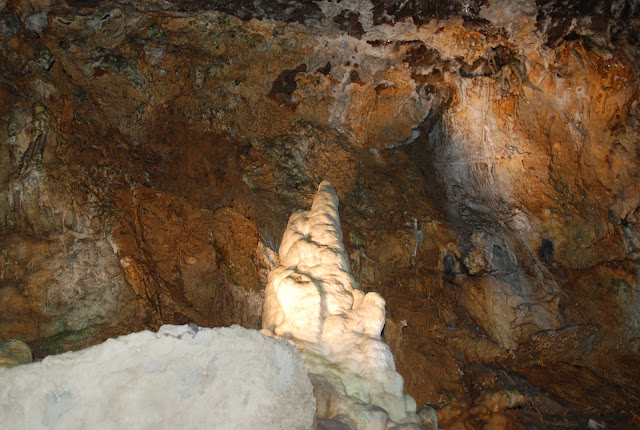 |
| Stalactites |
The Crystal Cave I saw on Friday looks the same now as when people first visited in the 1870s. It takes about five hundred years for a stalactite (hanging from the top) or a stalagmite (growing up from the floor from stalactite drips) to gain one to three inches. Both of these are made from calcium carbonate. If they meet in the middle, they are called a column. Crystal Cave has some of these. It is considered a live cave because it is currently still affected by water even though no large quantities run through it changing its shapes and cavities. There is still seepage which causes the formations to change ever-so-slightly over centuries. The forty-five minute cave walk we experienced was damp and cool: the temperature stays constant at 54 degrees. There is very little life inside. Bats live in there, although we didn't see any, and tiny bits of moss where there is (artificial) light. If any ferns or other types of plants grow, their seed probably came in on someone's foot. Volunteers carefully remove any kind of plant life in order to preserve the rock formations.
 |
| Stalagmites: these are called the Prairie Dogs. |
 |
| A huge formation of flowstone, created by running water |
Two farmers discovered the cave in 1871 when they were working in a stone quarry. They ventured inside but were turned back by the darkness. Our tour guide let us experience that total darkness by turning out the lights that illuminate the various formations for an uncomfortably long time. This put me on edge more than I would like to admit, and I stood stalagmite-still in my spot for the duration. Those original farmer-discoverers talked up the cave and returned the next day with more guys, candles, and coal oil lanterns. They were fascinated by the formations, textures, and colors which they considered God's artistry. One of the first farmers to explore the cave, Samuel D.F. Kohler, purchased the land in 1872 and began accompanying visitors into the cave. He was the one who built the door to the cave to keep out anyone who might want to damage it. Well, more people came, he built a hotel, more people came, he ran buggies to and from the train station, and eventually his son David sold the property in 1923 to the Crystal Cave Company which still owns it and runs it today.
 |
| Stairs in the cave |
So Fred and I, being Fred and me, gazed in wonder at the cool formations, but equally at the concrete walkways and stairs. How did they build those? Keep in mind there is a limited opening, tight corners, stuff hanging from the top and pointing up from the bottom. You probably couldn't run a concrete shoot in there, let alone get a truck anywhere near. How do even build the forms for the concrete stairs?
 |
| This is the Historic Inn, portions built in 1799 and 1876. The gift shop is in there now. |
This was a cool exploration for a late-springtime day. We finished the afternoon at the gift shop in the Historic Inn. I bought my usual post cards and informational booklet, and Fred contemplated some snack foods. These are real, not candy made to look like creatures. "We bought some as a joke, but didn't think they would sell. They did and we had to reorder a case!"
 |
| Snacks. (Photo courtesy of Fred Peters) |







No comments:
Post a Comment